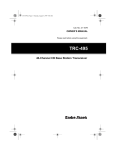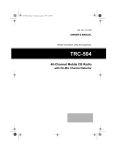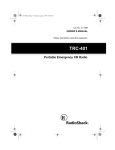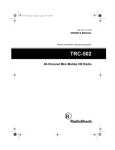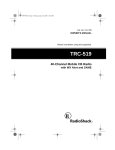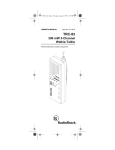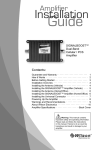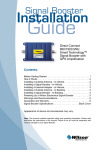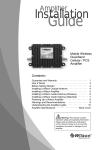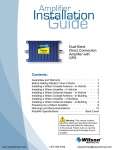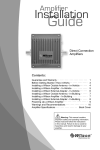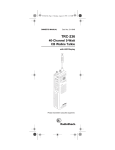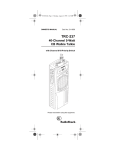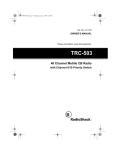Download Radio Shack TRC-494 Owner`s manual
Transcript
21-1589.fm Page 1 Thursday, August 5, 1999 10:10 AM Cat. No. 21-1589 OWNER’S MANUAL Please read before using this equipment. TRC-494 40-Channel Emergency Citizen’s Band Weatheradio 21-1589.fm Page 1 Thursday, August 5, 1999 10:10 AM Cat. No. 21-1589 OWNER’S MANUAL Please read before using this equipment. TRC-494 40-Channel Emergency Citizen’s Band Weatheradio 21-1589.fm Page 2 Thursday, August 5, 1999 10:10 AM INTRODUCTION Your Radio Shack TRC-494 is a 40channel emergency citizen’s band weatheradio that is specially designed for emergency situations. It comes with a handy carrying case so you can easily move it from one vehicle to another. And, the TRC-494 is also a 3-channel weatheradio, which you can use to receive weather information 24 hours a day. You can power the TRC-494 from the cigarette-lighter socket in any vehicle that has a 12-volt, negative ground electrical system. You can also power the CB from the supplied battery pack. Its features include: CB/Weatheradio Switch — lets you quickly switch from the CB to the weatheradio function. Emergency Channel 9 Switch — immediately switches the CB to Channel 9, the universal emergency channel. PLL (Phase-Locked Loop) Frequency Synthesizer — provides reliable and exact tuning using a frequency reference crystal. Digital Channel-Number Display — makes it easy to see which channel is selected. Range Control — lets you eliminate background noise when no strong signals are present. Built-In Ceramic Filters — provide superior selectivity and prevent adjacent-channel interference. Built-In Automatic Noise Limiter (ANL) — reduces noise caused by nearby electrical equipment, such as motors or automotive ignition systems. External Antenna Jack — lets you connect the TRC-494 to an external CB radio antenna. Note: The TRC-494 comes with a telescoping antenna that you can attach directly to the CB. You can also attach it to the supplied magnetmount base for use when your vehicle is not moving. If you plan to use the CB when your vehicle is moving, we recommend that you purchase a standard mount antenna. Important: REACT is a nationwide 24-hour network that monitors Channel 9. Switch to Channel 9 in an emergency, and report the problem. Note: REACT might not be available in all areas. © 1996 Tandy Corporation. All Rights Reserved. Radio Shack is a registered trademark used by Tandy Corporation. 2 21-1589.fm Page 2 Thursday, August 5, 1999 10:10 AM INTRODUCTION Your Radio Shack TRC-494 is a 40channel emergency citizen’s band weatheradio that is specially designed for emergency situations. It comes with a handy carrying case so you can easily move it from one vehicle to another. And, the TRC-494 is also a 3-channel weatheradio, which you can use to receive weather information 24 hours a day. You can power the TRC-494 from the cigarette-lighter socket in any vehicle that has a 12-volt, negative ground electrical system. You can also power the CB from the supplied battery pack. Its features include: CB/Weatheradio Switch — lets you quickly switch from the CB to the weatheradio function. Emergency Channel 9 Switch — immediately switches the CB to Channel 9, the universal emergency channel. PLL (Phase-Locked Loop) Frequency Synthesizer — provides reliable and exact tuning using a frequency reference crystal. Digital Channel-Number Display — makes it easy to see which channel is selected. Range Control — lets you eliminate background noise when no strong signals are present. Built-In Ceramic Filters — provide superior selectivity and prevent adjacent-channel interference. Built-In Automatic Noise Limiter (ANL) — reduces noise caused by nearby electrical equipment, such as motors or automotive ignition systems. External Antenna Jack — lets you connect the TRC-494 to an external CB radio antenna. Note: The TRC-494 comes with a telescoping antenna that you can attach directly to the CB. You can also attach it to the supplied magnetmount base for use when your vehicle is not moving. If you plan to use the CB when your vehicle is moving, we recommend that you purchase a standard mount antenna. Important: REACT is a nationwide 24-hour network that monitors Channel 9. Switch to Channel 9 in an emergency, and report the problem. Note: REACT might not be available in all areas. © 1996 Tandy Corporation. All Rights Reserved. Radio Shack is a registered trademark used by Tandy Corporation. 2 21-1589.fm Page 3 Thursday, August 5, 1999 10:10 AM For your records, we urge you to record your CB’s serial number in the space below. The serial number is on the CB’s back panel. Serial Number:_________________ FCC INFORMATION The Federal Communications Commission (FCC) does not require you to have a license to operate this CB. However, the FCC does require you to read and know Part 95 of FCC Rules. These rules apply to the operation of a Class D CB. We have provided a copy of these regulations with your CB. Your CB might cause TV or radio interference even when it is operating properly. To determine if your CB is causing the interference, turn off your CB. If the interference goes away, your CB is causing it. Try to eliminate the interference by: • Moving your CB away from the receiver. • Contacting your local Shack store for help. Radio If you cannot eliminate the interference, the FCC requires that you stop using your CB. Warning: Do not open your CB to make any internal adjustments. Internal adjustments can be made only by authorized service personnel. Internal adjustments and/or modifications can lead to illegal operation as defined by Part 95 of FCC Rules. Such illegal operation can lead to very serious consequences. To be safe and sure: • Never open your CB’s case. • Never modify your CB. 3 21-1589.fm Page 3 Thursday, August 5, 1999 10:10 AM For your records, we urge you to record your CB’s serial number in the space below. The serial number is on the CB’s back panel. Serial Number:_________________ FCC INFORMATION The Federal Communications Commission (FCC) does not require you to have a license to operate this CB. However, the FCC does require you to read and know Part 95 of FCC Rules. These rules apply to the operation of a Class D CB. We have provided a copy of these regulations with your CB. Your CB might cause TV or radio interference even when it is operating properly. To determine if your CB is causing the interference, turn off your CB. If the interference goes away, your CB is causing it. Try to eliminate the interference by: • Moving your CB away from the receiver. • Contacting your local Shack store for help. Radio If you cannot eliminate the interference, the FCC requires that you stop using your CB. Warning: Do not open your CB to make any internal adjustments. Internal adjustments can be made only by authorized service personnel. Internal adjustments and/or modifications can lead to illegal operation as defined by Part 95 of FCC Rules. Such illegal operation can lead to very serious consequences. To be safe and sure: • Never open your CB’s case. • Never modify your CB. 3 21-1589.fm Page 4 Thursday, August 5, 1999 10:10 AM CONTENTS PREPARATION ............................................................................................... Supplying Power......................................................................................... Using Vehicle Battery Power ............................................................... Installing the Battery Pack .................................................................. Attaching the Antenna ................................................................................ Attaching the Antenna Directly to the CB ............................................ Using the Antenna’s Magnetic Base ................................................... 5 5 5 5 6 6 7 USING THE CB ............................................................................................... 8 Setting RANGE ............................................................................................ 9 USING THE WEATHERADIO ........................................................................ 10 CB OPERATION TIPS .................................................................................... 11 Common Uses for a CB Radio .................................................................. 11 Business Uses ................................................................................... 11 Personal Uses .................................................................................... 11 CB Courtesy ............................................................................................. 12 Maximum Range ...................................................................................... 12 Using Common 10-Codes ........................................................................ 13 TROUBLESHOOTING .................................................................................. 14 Reducing Noise ........................................................................................ 15 MAINTENANCE ............................................................................................ 16 Replacing the Power Cord’s Fuse ............................................................ 17 SPECIFICATIONS ......................................................................................... 18 4 21-1589.fm Page 4 Thursday, August 5, 1999 10:10 AM CONTENTS PREPARATION ............................................................................................... Supplying Power......................................................................................... Using Vehicle Battery Power ............................................................... Installing the Battery Pack .................................................................. Attaching the Antenna ................................................................................ Attaching the Antenna Directly to the CB ............................................ Using the Antenna’s Magnetic Base ................................................... 5 5 5 5 6 6 7 USING THE CB ............................................................................................... 8 Setting RANGE ............................................................................................ 9 USING THE WEATHERADIO ........................................................................ 10 CB OPERATION TIPS .................................................................................... 11 Common Uses for a CB Radio .................................................................. 11 Business Uses ................................................................................... 11 Personal Uses .................................................................................... 11 CB Courtesy ............................................................................................. 12 Maximum Range ...................................................................................... 12 Using Common 10-Codes ........................................................................ 13 TROUBLESHOOTING .................................................................................. 14 Reducing Noise ........................................................................................ 15 MAINTENANCE ............................................................................................ 16 Replacing the Power Cord’s Fuse ............................................................ 17 SPECIFICATIONS ......................................................................................... 18 4 21-1589.fm Page 5 Thursday, August 5, 1999 10:10 AM PREPARATION SUPPLYING POWER Installing the Battery Pack Using Vehicle Battery Power Your CB uses eight AA batteries for power. For the best performance and longest life, we recommend alkaline batteries, such as Radio Shack Cat. No. 23-552. Follow these steps to power the CB from your vehicle’s battery. 1. Plug the small end of the supplied power cord into DC 12V on the side of the CB. Note: When you connect the DC power cord to the CB, the battery pack automatically disconnects. Follow these steps to install the batteries in the battery pack and attach the battery pack to the CB. Caution: Before plugging the power cord’s cigarette-lighter plug into your vehicle’s cigarette-lighter socket, make sure the tip is screwed firmly onto the plug (see “Replacing the Power Cord’s Fuse” on Page 17). 1. Press down and slide the battery pack’s latch in the direction of the arrow. While holding the latch, slide the battery pack off to the right. 2. Plug the other end of the power cord into the cigarette-lighter socket. Notes: • If the CB does not operate properly when you are using the DC power cord, check that the lighter socket is clean and free of ashes or other debris. • If the unit still does not work, check the fuse in the DC power cord (see “Replacing the Power Cord’s Fuse” on Page 17). 5 2. Push down on the center of the battery pack’s top to remove the battery holder from the battery pack case. 21-1589.fm Page 5 Thursday, August 5, 1999 10:10 AM PREPARATION SUPPLYING POWER Installing the Battery Pack Using Vehicle Battery Power Your CB uses eight AA batteries for power. For the best performance and longest life, we recommend alkaline batteries, such as Radio Shack Cat. No. 23-552. Follow these steps to power the CB from your vehicle’s battery. 1. Plug the small end of the supplied power cord into DC 12V on the side of the CB. Note: When you connect the DC power cord to the CB, the battery pack automatically disconnects. Follow these steps to install the batteries in the battery pack and attach the battery pack to the CB. Caution: Before plugging the power cord’s cigarette-lighter plug into your vehicle’s cigarette-lighter socket, make sure the tip is screwed firmly onto the plug (see “Replacing the Power Cord’s Fuse” on Page 17). 1. Press down and slide the battery pack’s latch in the direction of the arrow. While holding the latch, slide the battery pack off to the right. 2. Plug the other end of the power cord into the cigarette-lighter socket. Notes: • If the CB does not operate properly when you are using the DC power cord, check that the lighter socket is clean and free of ashes or other debris. • If the unit still does not work, check the fuse in the DC power cord (see “Replacing the Power Cord’s Fuse” on Page 17). 5 2. Push down on the center of the battery pack’s top to remove the battery holder from the battery pack case. 21-1589.fm Page 6 Thursday, August 5, 1999 10:10 AM 3. Install the batteries in the holder as indicated by the polarity symbols (+ and –) marked on the holder. 4. Slide the battery pack’s case over the holder until it snaps into place. Note: The case slides over holder in only one direction. doesn’t slide into place on first try, do not force it! Turn case over and try again. the If it the the 5. From the right side of the CB, slide the battery pack onto the bottom of the CB until it clicks into place. To test the batteries, press BATT TEST on the battery pack. If the indicator lights, the batteries are still good. If the indicator does not light, replace all eight batteries. 6 ATTACHING THE ANTENNA You can attach the supplied telescoping antenna to the supplied magnetic base or directly to the CB. In either case, fully extend the antenna for maximum range. Attaching the Antenna Directly to the CB To attach the antenna directly to the CB, simply screw the antenna into the CB’s ROD ANT jack. 21-1589.fm Page 6 Thursday, August 5, 1999 10:10 AM 3. Install the batteries in the holder as indicated by the polarity symbols (+ and –) marked on the holder. 4. Slide the battery pack’s case over the holder until it snaps into place. Note: The case slides over holder in only one direction. doesn’t slide into place on first try, do not force it! Turn case over and try again. the If it the the 5. From the right side of the CB, slide the battery pack onto the bottom of the CB until it clicks into place. To test the batteries, press BATT TEST on the battery pack. If the indicator lights, the batteries are still good. If the indicator does not light, replace all eight batteries. 6 ATTACHING THE ANTENNA You can attach the supplied telescoping antenna to the supplied magnetic base or directly to the CB. In either case, fully extend the antenna for maximum range. Attaching the Antenna Directly to the CB To attach the antenna directly to the CB, simply screw the antenna into the CB’s ROD ANT jack. 21-1589.fm Page 7 Thursday, August 5, 1999 10:10 AM Using the Antenna’s Magnetic Base 3. Plug the magnetic base’s wire into EXT ANT. Note: The supplied magnetic mount base is designed for emergency use only while your vehicle is stopped. If you want to use the CB when the vehicle is moving, you need an optional standard mount antenna (available at your local Radio Shack store). You also need a plug adapter (Cat. No. 278-208) to connect the standard antenna’s PL-259 plug to EXT ANT on your CB. 1. While your vehicle is stopped, screw the antenna into the hole on top of the magnetic base. 2. Place the base as near as possible to the center of your vehicle’s roof. Warning: Do not remove the metallic backing on the bottom of the magnetic base. 7 21-1589.fm Page 7 Thursday, August 5, 1999 10:10 AM Using the Antenna’s Magnetic Base 3. Plug the magnetic base’s wire into EXT ANT. Note: The supplied magnetic mount base is designed for emergency use only while your vehicle is stopped. If you want to use the CB when the vehicle is moving, you need an optional standard mount antenna (available at your local Radio Shack store). You also need a plug adapter (Cat. No. 278-208) to connect the standard antenna’s PL-259 plug to EXT ANT on your CB. 1. While your vehicle is stopped, screw the antenna into the hole on top of the magnetic base. 2. Place the base as near as possible to the center of your vehicle’s roof. Warning: Do not remove the metallic backing on the bottom of the magnetic base. 7 21-1589.fm Page 8 Thursday, August 5, 1999 10:10 AM USING THE CB Before you start using your CB, you should know how to use it effectively and courteously. “CB Operation Tips” contains information that will help you use and enjoy your CB. Note: Before you operate the CB, be sure you connect a power source and an antenna to the CB. 1. Turn VOLUME clockwise to turn on the CB. The volume level appears in the VOLUME window. 2. Set WEATHERADIO-ABC/CB to CB . 3. Turn RANGE fully counterclockwise to set it to 10. 8 Note: To eliminate background noise, see “Setting Range.” 4. Select a channel as follows: • To immediately select Channel 9, set CH 9 to IN. Channel 9 is used for emergencies and traveler assistance. • To select any other channel, set CH 9 to OUT. Then press CHANNEL UP or DOWN to select a channel. Note: To check the selected channel number, press DISPLAY on the side of the CB. The number appears for 20 seconds. 5. To transmit, hold the CB 2-3 inches from your mouth, press and hold down PUSH TO TALK on the side of the CB, and speak directly into the built-in microphone. 21-1589.fm Page 8 Thursday, August 5, 1999 10:10 AM USING THE CB Before you start using your CB, you should know how to use it effectively and courteously. “CB Operation Tips” contains information that will help you use and enjoy your CB. Note: Before you operate the CB, be sure you connect a power source and an antenna to the CB. 1. Turn VOLUME clockwise to turn on the CB. The volume level appears in the VOLUME window. 2. Set WEATHERADIO-ABC/CB to CB . 3. Turn RANGE fully counterclockwise to set it to 10. 8 Note: To eliminate background noise, see “Setting Range.” 4. Select a channel as follows: • To immediately select Channel 9, set CH 9 to IN. Channel 9 is used for emergencies and traveler assistance. • To select any other channel, set CH 9 to OUT. Then press CHANNEL UP or DOWN to select a channel. Note: To check the selected channel number, press DISPLAY on the side of the CB. The number appears for 20 seconds. 5. To transmit, hold the CB 2-3 inches from your mouth, press and hold down PUSH TO TALK on the side of the CB, and speak directly into the built-in microphone. 21-1589.fm Page 9 Thursday, August 5, 1999 10:10 AM In an emergency, broadcast your “CLIP”: SETTING RANGE Call sign — identify yourself Location — be exact Injuries — number of injured, type of injuries, and so on Problem — give complete details. Give information calmly, clearly, and in as few words as possible 6. When you finish transmitting, release PUSH TO TALK. You can now receive transmissions. Adjust VOLUME to the desired listening level. 7. To turn off the CB, turn VOLUME counterclockwise (toward the top of the CB) until you hear it click and OFF appears in the VOLUME window. Because this is primarily an emergency CB, we suggest you leave RANGE set to 10 when you store the CB. This ensures the maximum reception range in an emergency. If you want to eliminate background noise when you are not receiving a strong signal from another CB, wait until you are not receiving a call and turn RANGE clockwise until the background noise stops. Note: VOLUME and RANGE only affect reception. They have no effect on transmissions. 9 21-1589.fm Page 9 Thursday, August 5, 1999 10:10 AM In an emergency, broadcast your “CLIP”: SETTING RANGE Call sign — identify yourself Location — be exact Injuries — number of injured, type of injuries, and so on Problem — give complete details. Give information calmly, clearly, and in as few words as possible 6. When you finish transmitting, release PUSH TO TALK. You can now receive transmissions. Adjust VOLUME to the desired listening level. 7. To turn off the CB, turn VOLUME counterclockwise (toward the top of the CB) until you hear it click and OFF appears in the VOLUME window. Because this is primarily an emergency CB, we suggest you leave RANGE set to 10 when you store the CB. This ensures the maximum reception range in an emergency. If you want to eliminate background noise when you are not receiving a strong signal from another CB, wait until you are not receiving a call and turn RANGE clockwise until the background noise stops. Note: VOLUME and RANGE only affect reception. They have no effect on transmissions. 9 21-1589.fm Page 10 Thursday, August 5, 1999 10:10 AM USING THE WEATHERADIO In the USA, detailed weather information is continuously broadcast on 372 government weather stations. Each station broadcasts on A — 162.400, B — 162.475, or C — 162.550 MHz. 2. Set WEATHERADIO-ABC/CB to A, B or C. Most weather stations use frequency C , but in locations where there might be interference between stations, the other two frequencies might be used. Choose the frequency that provides the best reception at your location. 3. Adjust VOLUME to the desired listening level. Notes: Follow these steps to receive weather information. Note: Before you use the weatheradio, be sure you connect a power source and an antenna to the CB. 1. Turn VOLUME clockwise to turn on the weatheradio. 10 • If reception is poor, try one of the other two weather station frequencies. • CH9, CHANNEL UP/DOWN, PUSH TO TALK, DISPLAY, and RANGE have no effect on weatheradio operation. 21-1589.fm Page 10 Thursday, August 5, 1999 10:10 AM USING THE WEATHERADIO In the USA, detailed weather information is continuously broadcast on 372 government weather stations. Each station broadcasts on A — 162.400, B — 162.475, or C — 162.550 MHz. 2. Set WEATHERADIO-ABC/CB to A, B or C. Most weather stations use frequency C , but in locations where there might be interference between stations, the other two frequencies might be used. Choose the frequency that provides the best reception at your location. 3. Adjust VOLUME to the desired listening level. Notes: Follow these steps to receive weather information. Note: Before you use the weatheradio, be sure you connect a power source and an antenna to the CB. 1. Turn VOLUME clockwise to turn on the weatheradio. 10 • If reception is poor, try one of the other two weather station frequencies. • CH9, CHANNEL UP/DOWN, PUSH TO TALK, DISPLAY, and RANGE have no effect on weatheradio operation. 21-1589.fm Page 11 Thursday, August 5, 1999 10:10 AM CB OPERATION TIPS Like most activities, CB radio use has its customs and courtesies. The following tips will help you get the most enjoyment from your CB. COMMON USES FOR A CB RADIO Business Uses • Truck drivers and delivery personnel can learn road and traffic conditions and get assistance in locating destinations. A CB is also good company on those “long hauls.” • On construction crews, a CB quickly pays for itself when you are calling for additional materials or coordinating the activities of different work crews. • For security officers, a CB is more than a convenience — it is a must for both safety and efficiency. Personal Uses • Keep in touch with home while driving to work, to the store, or to a social activity. Let your family know you are tied up in traffic or that you will stop by the store on the way home. • If you are a two-car (or more) family, CBs are great for communicating with family members while they are in their cars. • Contact friends or neighbors — find out “what’s happening” or plan a get-together. • Ever have car trouble or run out of gas on the highway? What a relief it is to be able to radio for assistance! • Camping, fishing, and other sports are more fun with a CB. Locate a buddy or find out “what’s cooking” back at camp. 11 21-1589.fm Page 11 Thursday, August 5, 1999 10:10 AM CB OPERATION TIPS Like most activities, CB radio use has its customs and courtesies. The following tips will help you get the most enjoyment from your CB. COMMON USES FOR A CB RADIO Business Uses • Truck drivers and delivery personnel can learn road and traffic conditions and get assistance in locating destinations. A CB is also good company on those “long hauls.” • On construction crews, a CB quickly pays for itself when you are calling for additional materials or coordinating the activities of different work crews. • For security officers, a CB is more than a convenience — it is a must for both safety and efficiency. Personal Uses • Keep in touch with home while driving to work, to the store, or to a social activity. Let your family know you are tied up in traffic or that you will stop by the store on the way home. • If you are a two-car (or more) family, CBs are great for communicating with family members while they are in their cars. • Contact friends or neighbors — find out “what’s happening” or plan a get-together. • Ever have car trouble or run out of gas on the highway? What a relief it is to be able to radio for assistance! • Camping, fishing, and other sports are more fun with a CB. Locate a buddy or find out “what’s cooking” back at camp. 11 21-1589.fm Page 12 Thursday, August 5, 1999 10:10 AM CB COURTESY MAXIMUM RANGE • Wait for a pause in someone else’s transmission before you ask for a break. The maximum range and quality of CB transmissions vary depending on these conditions: • If you do not receive an answer to your call after a second attempt, sign off and wait several minutes before trying again. • The type and quality of antenna used • Do not hold down the PUSH TO TALK button when you are not talking. (This is called dead keying.) • Assist callers with directions, road conditions, and any other reasonable requests. • The height of the antenna’s mounting location — the higher the antenna, the better the signal’s range • The surrounding terrain — mountains and tall buildings limit the range • Weather conditions • The current setting of RANGE on your CB • The number of nearby CBs operating on the same channel • Standing Wave Ratio (SWR) between the antenna and the CB. You can check the SWR between the CB and a mobile antenna using an SWR tester (Cat. No. 21-523). Follow the instructions supplied with the SWR tester and the mobile antenna to change the SWR, if necessary. 12 21-1589.fm Page 12 Thursday, August 5, 1999 10:10 AM CB COURTESY MAXIMUM RANGE • Wait for a pause in someone else’s transmission before you ask for a break. The maximum range and quality of CB transmissions vary depending on these conditions: • If you do not receive an answer to your call after a second attempt, sign off and wait several minutes before trying again. • The type and quality of antenna used • Do not hold down the PUSH TO TALK button when you are not talking. (This is called dead keying.) • Assist callers with directions, road conditions, and any other reasonable requests. • The height of the antenna’s mounting location — the higher the antenna, the better the signal’s range • The surrounding terrain — mountains and tall buildings limit the range • Weather conditions • The current setting of RANGE on your CB • The number of nearby CBs operating on the same channel • Standing Wave Ratio (SWR) between the antenna and the CB. You can check the SWR between the CB and a mobile antenna using an SWR tester (Cat. No. 21-523). Follow the instructions supplied with the SWR tester and the mobile antenna to change the SWR, if necessary. 12 21-1589.fm Page 13 Thursday, August 5, 1999 10:10 AM USING COMMON 10CODES Citizen’s band operators have largely adopted the 10-codes for standard questions and answers. Their use permits faster communication and better intelligibility in noisy areas. This table lists the codes adopted by the Associated Public Safety Communications Officers (APCO). Code Meaning 10-1 Cannot understand your message. 10-2 Your signal is good. 10-3 Stop transmitting. 10-4 Message received and understood. 10-5 Relay information to __________. 10-6 I am busy. 10-7 Out of service. 10-8 In service. 10-9 Repeat last message. 10-10 Negative (No). 10-11 _____________ in service. 10-12 Stand by. 10-13 Report ___________ conditions. Code Meaning 10-14 Information. 10-15 Message delivered. 10-16 Reply to message. 10-17 En route. 10-18 Urgent. 10-19 Contact __________. 10-20 My location is __________. 10-21 Call ________ by telephone. 10-22 Cancel last message. 10-23 Arrived at the scene. 10-24 Assignment complete. 10-26 Estimated time of arrival is _________. 10-30 Use caution. 10-31 Pick up. 10-33 Emergency traffic. Clear the channel. 10-34 The time is _____. Note: Although this table lists the 10codes’ meanings in the form of a statement, they can also be phrased as questions (10-6: Are you busy?, 10-20: What is your location?). 13 21-1589.fm Page 13 Thursday, August 5, 1999 10:10 AM USING COMMON 10CODES Citizen’s band operators have largely adopted the 10-codes for standard questions and answers. Their use permits faster communication and better intelligibility in noisy areas. This table lists the codes adopted by the Associated Public Safety Communications Officers (APCO). Code Meaning 10-1 Cannot understand your message. 10-2 Your signal is good. 10-3 Stop transmitting. 10-4 Message received and understood. 10-5 Relay information to __________. 10-6 I am busy. 10-7 Out of service. 10-8 In service. 10-9 Repeat last message. 10-10 Negative (No). 10-11 _____________ in service. 10-12 Stand by. 10-13 Report ___________ conditions. Code Meaning 10-14 Information. 10-15 Message delivered. 10-16 Reply to message. 10-17 En route. 10-18 Urgent. 10-19 Contact __________. 10-20 My location is __________. 10-21 Call ________ by telephone. 10-22 Cancel last message. 10-23 Arrived at the scene. 10-24 Assignment complete. 10-26 Estimated time of arrival is _________. 10-30 Use caution. 10-31 Pick up. 10-33 Emergency traffic. Clear the channel. 10-34 The time is _____. Note: Although this table lists the 10codes’ meanings in the form of a statement, they can also be phrased as questions (10-6: Are you busy?, 10-20: What is your location?). 13 21-1589.fm Page 14 Thursday, August 5, 1999 10:10 AM TROUBLESHOOTING If your CB is not working as it should, follow the suggestions below to see if you can eliminate the problem. If you cannot, take the CB to your local Radio Shack store for assistance. Symptom CHANNEL UP/DOWN buttons do not work. Remedy • If CH 9 is set to IN, set it to OUT, then use the CHANNEL UP/DOWN buttons. • Set WEATHERADIO-ABC/CB to CB. No channel display. • Press DISPLAY. The CB displays the channel. • Set WEATHERADIO-ABC/CB to CB. Not transmitting well. • Set WEATHERADIO-ABC/CB to CB. • Fully press PUSH TO TALK. • Secure the antenna connection. • Fully extend the antenna. Not receiving well. • Set WEATHERADIO-ABC/CB to CB. • Properly adjust RANGE. • Properly adjust VOLUME. • Secure the antenna connection. • Fully extend the antenna. No weatheradio reception. • Set WEATHERADIO-ABC/CB to WEATHERADIOA, B, or C. • Set it to the channel that provides the best reception. • Fully extend the antenna. CB does not operate at all. • Check the DC power connection. • Replace the blown fuse in the power cord. • Insufficient battery pack power. Press BATT TEST to check, and replace the batteries, if necessary. • Turn on VOLUME. 14 21-1589.fm Page 14 Thursday, August 5, 1999 10:10 AM TROUBLESHOOTING If your CB is not working as it should, follow the suggestions below to see if you can eliminate the problem. If you cannot, take the CB to your local Radio Shack store for assistance. Symptom CHANNEL UP/DOWN buttons do not work. Remedy • If CH 9 is set to IN, set it to OUT, then use the CHANNEL UP/DOWN buttons. • Set WEATHERADIO-ABC/CB to CB. No channel display. • Press DISPLAY. The CB displays the channel. • Set WEATHERADIO-ABC/CB to CB. Not transmitting well. • Set WEATHERADIO-ABC/CB to CB. • Fully press PUSH TO TALK. • Secure the antenna connection. • Fully extend the antenna. Not receiving well. • Set WEATHERADIO-ABC/CB to CB. • Properly adjust RANGE. • Properly adjust VOLUME. • Secure the antenna connection. • Fully extend the antenna. No weatheradio reception. • Set WEATHERADIO-ABC/CB to WEATHERADIOA, B, or C. • Set it to the channel that provides the best reception. • Fully extend the antenna. CB does not operate at all. • Check the DC power connection. • Replace the blown fuse in the power cord. • Insufficient battery pack power. Press BATT TEST to check, and replace the batteries, if necessary. • Turn on VOLUME. 14 21-1589.fm Page 15 Thursday, August 5, 1999 10:10 AM REDUCING NOISE Because your CB is exceptionally quiet, any noise you hear is probably from an external source in your vehicle — the ignition, another radio, spark plugs, and so forth. You can determine the source of the noise by turning off the engine and operating the CB with the ignition set to ACC. If most or all of the noise goes away, the problem is in your vehicle’s ignition or electrical system. Here are a few hints to help you reduce or eliminate such noise: • If problems persist, check your alternator/generator and regulator gauges. Noise from these sources can be reduced or eliminated using bypass capacitors at the various voltage points. Note: Your local Radio Shack store has a wide selection of noise-suppression equipment. • Do not route the DC power cord next to the antenna wire. • Be sure the antenna’s magnetic base is securely attached to a metallic surface. If you use an antenna other than the magnetic-mount type, be sure that the vehicle battery’s ground connection is secure. • Replace old ignition wires with new, high-voltage, noise-suppression ignition wires. • Install noise suppressors on your spark plugs or install spark plugs that have built-in suppressors. 15 21-1589.fm Page 15 Thursday, August 5, 1999 10:10 AM REDUCING NOISE Because your CB is exceptionally quiet, any noise you hear is probably from an external source in your vehicle — the ignition, another radio, spark plugs, and so forth. You can determine the source of the noise by turning off the engine and operating the CB with the ignition set to ACC. If most or all of the noise goes away, the problem is in your vehicle’s ignition or electrical system. Here are a few hints to help you reduce or eliminate such noise: • If problems persist, check your alternator/generator and regulator gauges. Noise from these sources can be reduced or eliminated using bypass capacitors at the various voltage points. Note: Your local Radio Shack store has a wide selection of noise-suppression equipment. • Do not route the DC power cord next to the antenna wire. • Be sure the antenna’s magnetic base is securely attached to a metallic surface. If you use an antenna other than the magnetic-mount type, be sure that the vehicle battery’s ground connection is secure. • Replace old ignition wires with new, high-voltage, noise-suppression ignition wires. • Install noise suppressors on your spark plugs or install spark plugs that have built-in suppressors. 15 21-1589.fm Page 16 Thursday, August 5, 1999 10:10 AM MAINTENANCE Your TRC-494 is an example of superior design and craftsmanship. The following suggestions will help you care for your TRC-494 so you can enjoy it for years. Keep the TRC-494 dry. If it gets wet, wipe it dry immediately. Liquids might contain minerals that can corrode the electronic circuits. Handle the TRC-494 gently and carefully. Dropping it can damage circuit boards and cases and can cause the TRC-494 to work improperly. Use and store the TRC-494 only in normal temperature environments. Temperature extremes can shorten the life of electronic devices and distort or melt plastic parts. Keep the TRC-494 away from dust and dirt, which can cause premature wear of parts. CLEANER Wipe the TRC-494 with a damp cloth occasionally to keep it looking new. Do not use harsh chemicals, cleaning solvents, or strong detergents to clean the TRC-494. Modifying or tampering with the TRC-494’s internal components can cause a malfunction and might invalidate your TRC-494’s warranty and void your FCC authorization to operate it. If your TRC-494 is not performing as it should, take it to your local Radio Shack store for assistance. 16 21-1589.fm Page 16 Thursday, August 5, 1999 10:10 AM MAINTENANCE Your TRC-494 is an example of superior design and craftsmanship. The following suggestions will help you care for your TRC-494 so you can enjoy it for years. Keep the TRC-494 dry. If it gets wet, wipe it dry immediately. Liquids might contain minerals that can corrode the electronic circuits. Handle the TRC-494 gently and carefully. Dropping it can damage circuit boards and cases and can cause the TRC-494 to work improperly. Use and store the TRC-494 only in normal temperature environments. Temperature extremes can shorten the life of electronic devices and distort or melt plastic parts. Keep the TRC-494 away from dust and dirt, which can cause premature wear of parts. CLEANER Wipe the TRC-494 with a damp cloth occasionally to keep it looking new. Do not use harsh chemicals, cleaning solvents, or strong detergents to clean the TRC-494. Modifying or tampering with the TRC-494’s internal components can cause a malfunction and might invalidate your TRC-494’s warranty and void your FCC authorization to operate it. If your TRC-494 is not performing as it should, take it to your local Radio Shack store for assistance. 16 21-1589.fm Page 17 Thursday, August 5, 1999 10:10 AM REPLACING THE POWER CORD’S FUSE The TRC-494’s 2-amp fuse helps protect your CB from power surges and short circuits. If the fuse is blown, replace it with a 2-amp, 250-volt, fast-acting fuse (Cat. No. 270-1052). Follow these steps to replace the fuse. 1. Unplug the power cord from the vehicle’s cigarette lighter and be sure the CB is turned off. 2. To open the cigarette-lighter plug and remove the fuse, turn either end counterclockwise and release it. 3. If the fuse is blown, replace it. Caution: Make sure you replace the fuse only with another fuse of the same type and rating. 4. To close the cigarette-lighter plug, put the open ends together, then turn either end clockwise. 17 21-1589.fm Page 17 Thursday, August 5, 1999 10:10 AM REPLACING THE POWER CORD’S FUSE The TRC-494’s 2-amp fuse helps protect your CB from power surges and short circuits. If the fuse is blown, replace it with a 2-amp, 250-volt, fast-acting fuse (Cat. No. 270-1052). Follow these steps to replace the fuse. 1. Unplug the power cord from the vehicle’s cigarette lighter and be sure the CB is turned off. 2. To open the cigarette-lighter plug and remove the fuse, turn either end counterclockwise and release it. 3. If the fuse is blown, replace it. Caution: Make sure you replace the fuse only with another fuse of the same type and rating. 4. To close the cigarette-lighter plug, put the open ends together, then turn either end clockwise. 17 21-1589.fm Page 18 Thursday, August 5, 1999 10:10 AM SPECIFICATIONS RECEIVER Frequency Coverage ...............................................(CB) 26.965 to 27.405 MHz (Weatheradio) 162.400, 162.475, 162.550 MHz Sensitivity (Maximum) ............................................................................ 0.25 uV Adjacent Channel Selectivity ................................................. . 60 dB (at 10 kHz) Squelch ........................................................................................................ 1 mV Audio Output .......................................................................... 0.28 W (10% THD) Current Drain ................................................................................. 85 – 550 mA TRANSMITTER Frequency Coverage ....................................................... 26.965 – 27.405 MHz Power Input (at 12 V DC) .............................................................................. 5 W Power Output .............................................................................................. 2.5 W Spurious Emission ..................................................................................... 70 dB Type of Modulation.........................................................................................A3E Frequency Tolerance ............................................................................. ±100 Hz Antenna............................................................................................. Telescoping Impedance ..............................................................................................50 ohms Current Drain at No Modulation ............................................ 600 mA to 800 mA Current Drain at Full Modulation ...........................................900 mA to 1200 mA Weight ........................................................................................ 15 oz. (425 gm) Dimensions (HWD) ................................................................... 95/8 x 211/16 x 19/16 (245 x 68 x 40 mm) Specifications are typical; individual units might vary. Specifications are subject to change and improvement without notice. 18 21-1589.fm Page 18 Thursday, August 5, 1999 10:10 AM SPECIFICATIONS RECEIVER Frequency Coverage ...............................................(CB) 26.965 to 27.405 MHz (Weatheradio) 162.400, 162.475, 162.550 MHz Sensitivity (Maximum) ............................................................................ 0.25 uV Adjacent Channel Selectivity ................................................. . 60 dB (at 10 kHz) Squelch ........................................................................................................ 1 mV Audio Output .......................................................................... 0.28 W (10% THD) Current Drain ................................................................................. 85 – 550 mA TRANSMITTER Frequency Coverage ....................................................... 26.965 – 27.405 MHz Power Input (at 12 V DC) .............................................................................. 5 W Power Output .............................................................................................. 2.5 W Spurious Emission ..................................................................................... 70 dB Type of Modulation.........................................................................................A3E Frequency Tolerance ............................................................................. ±100 Hz Antenna............................................................................................. Telescoping Impedance ..............................................................................................50 ohms Current Drain at No Modulation ............................................ 600 mA to 800 mA Current Drain at Full Modulation ...........................................900 mA to 1200 mA Weight ........................................................................................ 15 oz. (425 gm) Dimensions (HWD) ................................................................... 95/8 x 211/16 x 19/16 (245 x 68 x 40 mm) Specifications are typical; individual units might vary. Specifications are subject to change and improvement without notice. 18 21-1589.fm Page 19 Thursday, August 5, 1999 10:10 AM NOTES 19 21-1589.fm Page 19 Thursday, August 5, 1999 10:10 AM NOTES 19 21-1589.fm Page 20 Thursday, August 5, 1999 10:10 AM RADIO SHACK LIMITED WARRANTY This product is warranted against defects for 90 days from date of purchase from Radio Shack company-owned stores and authorized Radio Shack franchisees and dealers. Within this period, we will repair it without charge for parts and labor. Simply bring your Radio Shack sales slip as proof of purchase date to any Radio Shack store. Warranty does not cover transportation costs. Nor does it cover a product subjected to misuse or accidental damage. EXCEPT AS PROVIDED HEREIN, RADIO SHACK MAKES NO EXPRESS WARRANTIES AND ANY IMPLIED WARRANTIES ARE LIMITED IN DURATION TO THE DURATION OF THE WRITTEN LIMITED WARRANTIES CONTAINED HEREIN. Some states do not permit limitation or exclusion of implied warranties; therefore, the aforesaid limitation(s) or exclusion(s) may not apply to the purchaser. This warranty gives you specific legal rights and you may also have other rights which vary from state to state. We Service What We Sell 9/94 RADIO SHACK A Division of Tandy Corporation Fort Worth, Texas 76102 5A5 Printed in Hong Kong 21-1589.fm Page 20 Thursday, August 5, 1999 10:10 AM RADIO SHACK LIMITED WARRANTY This product is warranted against defects for 90 days from date of purchase from Radio Shack company-owned stores and authorized Radio Shack franchisees and dealers. Within this period, we will repair it without charge for parts and labor. Simply bring your Radio Shack sales slip as proof of purchase date to any Radio Shack store. Warranty does not cover transportation costs. Nor does it cover a product subjected to misuse or accidental damage. EXCEPT AS PROVIDED HEREIN, RADIO SHACK MAKES NO EXPRESS WARRANTIES AND ANY IMPLIED WARRANTIES ARE LIMITED IN DURATION TO THE DURATION OF THE WRITTEN LIMITED WARRANTIES CONTAINED HEREIN. Some states do not permit limitation or exclusion of implied warranties; therefore, the aforesaid limitation(s) or exclusion(s) may not apply to the purchaser. This warranty gives you specific legal rights and you may also have other rights which vary from state to state. We Service What We Sell 9/94 RADIO SHACK A Division of Tandy Corporation Fort Worth, Texas 76102 5A5 Printed in Hong Kong








































